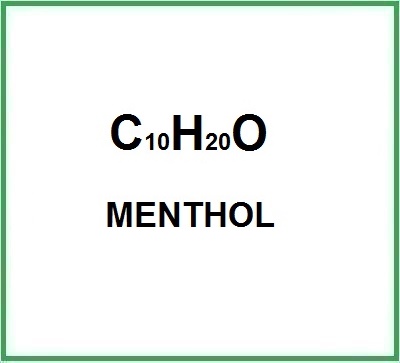The diction Menthol refers both to a synthetic chemical inorganic compound, and to a natural monoterpene. In nature it is a natural terpene alcohol found in mint oil and various essential oils. It is known for its refreshing and local anesthetic properties.
Raw Materials and Their Functions
Menthol. A natural organic compound known for its cooling and anesthetic properties. It is commonly extracted from peppermint oil or synthesized artificially.
Peppermint Oil. As above. A natural source of menthol, obtained by steam distillation of peppermint leaves. Contains a high percentage of natural menthol.
Chemical Reagents. Used in the artificial synthesis of menthol, including processes like the hydrogenation of compounds such as thymol.
Industrial Production of Menthol
- Natural Extraction. Menthol is extracted from peppermint oil through steam distillation processes and subsequent crystallization.
- Artificial Synthesis. Menthol can also be artificially synthesized by reacting compounds like thymol with hydrogen, in the presence of a catalyst.
- Purification. After extraction or synthesis, menthol is purified to remove impurities and concentrate the compound.
- Quality Control and Packaging. The purified menthol undergoes quality checks to ensure it meets the required standards. After quality control, it is packaged for use in pharmaceuticals, cosmetics, food products, and as a flavoring in various products.
Form and Color
Commonly appears in a solid crystalline form, colorless or white.

What it is used for and where
It artificially imparts the taste and scent of mint and is produced as an oil, alcohol or extract.
Much used in cigarettes, baked goods, pharmaceuticals, beverages, chewing gum, toothpastes, mouthwashes.
Cosmetics
It is a restricted ingredient as III/338 a Relevant Item in the Annexes of the European Cosmetics Regulation 1223/2009. Substance or ingredient reported: Menthol; dl-menthol; l-menthol; d-menthol. The presence of the substance shall be indicated in the list of ingredients referred to in Article 19(1), point (g), when its concentration exceeds: — 0,001 % in leave-on products — 0,01 % in rinse-off products.
Denaturant. It makes cosmetics unpalatable. It is sometimes added to cosmetics containing ethyl alcohol to make it unsuitable for ingestion. The ionic or polar molecules of this ingredient included in formulations that interact with protein groups, modulate the properties of the solution to suit specific needs.
Fragrance. It plays a decisive and important role in the formulation of cosmetic products as it provides the possibility of enhancing, masking or adding fragrance to the final product, increasing its marketability. It is able to create a perceptible pleasant odour, masking a bad smell. The consumer always expects to find a pleasant or distinctive scent in a cosmetic product.
Refreshing. This ingredient is included in cosmetic products to provide a refreshing or toning sensation to the skin and can also help relieve irritation or redness.
Soothing. Ingredient with the task of restoring moisture to the skin, helping in the healing process of irritation, inflammation and skin disorders.
Commercial applications:
Pharmaceutical and Cosmetic Industry: Menthol is widely used in pharmaceuticals, cosmetics, and personal care products such as creams, ointments, lip balms, toothpaste, and fresh breath products.
Oral Care Products: Contributes to the fresh feeling in toothpaste and mouthwashes.
Aromatherapy: Menthol is also used in aromatherapy for its relaxing and calming properties.
Menthol studies
- Molecular Formula: C10H20O
- Molecular Weight: 156.269 g/mol
- CAS: 89-78-1 491-01-0 1490-04-6 15356-70-4
- EC Number: 201-939-0 216-074-4 239-388-3 207-723-2
- FEMA Number: 2665
- PubChem Substance ID 57651951
- MDL number: MFCD00001484
- Beilstein Registry Number: 3194263
Synonyms:
- Menthol, (1alpha,2beta,5alpha)-Isomer
- dl-Menthol
- Levomenthol
- Cyclohexanol, 5-methyl-2-(1-methylethyl)-
- 2-Isopropyl-5-methylcyclohexanol
- Racementhol
- (+/-)-Menthol
- 5-Methyl-2-(1-methylethyl)cyclohexanol
- 3-p-Menthol
- 2-Isopropyl-5-methylcyclohexan-1-ol
- 1-methyl-4-isopropyl-3-hydroxycyclohexane
- 4-Isopropyl-1-methylcyclohexan-3-ol
- 3-Hydroxy-p-menthane
- (1S, 2S, 5R)-(+)-Neomenthol
- Cyclohexanol, 5-methyl-2-(1-methylethyl)-, [1S-(1.alpha.,2.alpha.,5.beta.)]-
- 5-methyl-2-(propan-2-yl)cyclohexanol
- Cyclohexanol, 5-methyl-2-(1-methylethyl)-, (1R,2S,5R)-rel-
- 5-methyl-2-propan-2-ylcyclohexan-1-ol
- Cyclohexanol, 5-methyl-2-(1-methylethyl)-, (1.alpha.,2.beta.,5.alpha.)-
![]() Menthol
Menthol 




